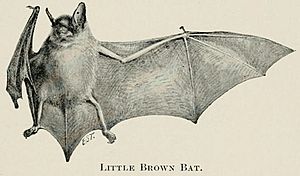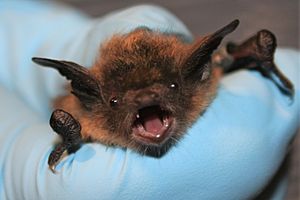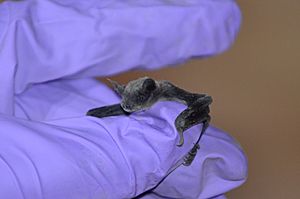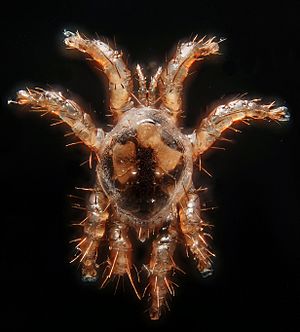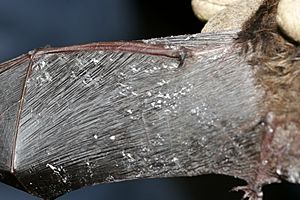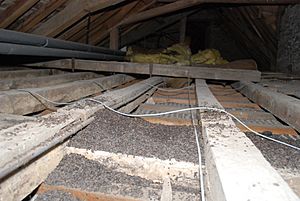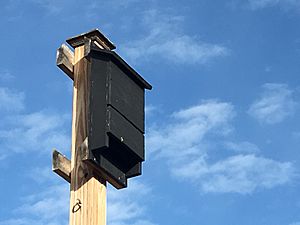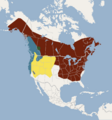Little brown bat facts for kids
Quick facts for kids Little brown bat |
|
|---|---|
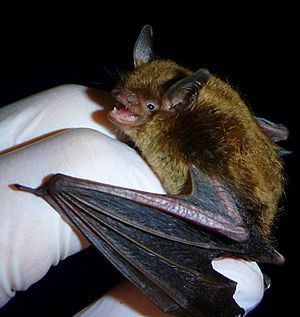 |
|
| Conservation status | |
| Scientific classification | |
| Genus: |
Myotis
|
| Species: |
lucifugus
|
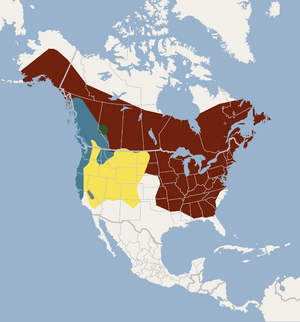 |
|
| Distribution of all little brown bat subspecies: M. l. lucifugus (red), M. l. pernox (green), M. l. alascensis (blue), M. l. carissima (yellow), M. l. relictus (gray) | |
| Synonyms | |
|
|
The little brown bat (Myotis lucifugus) is a small bat found across North America. It has shiny brown fur and is similar to other mouse-eared bats. These include the Indiana bat and northern long-eared bat. Even though it's called the "little brown bat," it is not closely related to the big brown bat.
Little brown bats are active at night. They hunt for insects and rest during the day in places like hollow trees or buildings. They use echolocation to find their way and catch prey. Females usually have one baby bat, called a pup, each year. Pups grow quickly and can fly and find their own food within a few weeks. These bats can live for about 6.5 years on average, but some have lived much longer, even up to 34 years!
Few animals hunt the little brown bat. Birds of prey like owls and animals like raccoons might catch them. However, diseases like rabies and white-nose syndrome are bigger threats. White-nose syndrome has caused a huge drop in their numbers since 2006. In some areas, like the Northeastern United States, bat populations have fallen by 90%.
People often see little brown bats because they sometimes live in buildings. While some people worry about them being pests or carrying rabies, these bats rarely have rabies. Some people even put up bat houses to attract them to their yards, but not inside their homes.
Contents
What is a Little Brown Bat?
How Scientists Name Bats: Taxonomy
The little brown bat was first described in 1831 by an American scientist named John Eatton Le Conte. He first named it Vespertilio lucifugus. The word "lucifugus" comes from Latin. It means "light-fleeing," which makes sense for a bat that is active at night.
This bat belongs to a group of bats called Vespertilionidae, or vesper bats. Within this family, it is part of the Myotis genus, which includes many "mouse-eared" bats. Scientists use DNA to understand how bats are related. Studies show that the little brown bat is closely related to the Arizona myotis.
There are five recognized types, or subspecies, of the little brown bat. These include M. l. lucifugus and M. l. alascensis. Some bats that were once thought to be subspecies, like the Arizona myotis, are now considered their own separate species.
Body Features of the Little Brown Bat
How Big Are Little Brown Bats?
The little brown bat is a small animal. It usually weighs between 5.5 and 12.5 grams (0.19 to 0.44 ounces). Its body length is about 8.0 to 9.5 centimeters (3.1 to 3.7 inches). Its wingspan can be from 22.2 to 26.9 centimeters (8.7 to 10.6 inches). Females are usually a bit larger than males.
Their fur can be light tan, reddish, or dark brown. The fur on their belly is lighter than on their back. Their fur often looks shiny. Sometimes, these bats can have unusual fur colors, like being completely white (albinism) or very dark (melanism).
Their Head and Teeth
Little brown bats have two sets of teeth during their lives. They start with "milk teeth" as babies, then grow adult teeth. Baby bats are born with 20 milk teeth. They lose these teeth and grow their 38 adult teeth by the time they are about 80 millimeters (3.1 inches) long.
They have a short snout and a gently sloped forehead. Their ears are about 11.0 to 15.5 millimeters (0.43 to 0.61 inches) long. They also have small, blunt flaps in front of their ears called tragi, which are important for hearing.
How Little Brown Bats Sense the World
Little brown bats can see some colors, including ultraviolet and red light. Seeing ultraviolet light might help them catch insects, as many moth wings reflect UV light. They are good at seeing in low light.
These bats rely heavily on echolocation. This means they send out sounds and listen for the echoes to create a "sound map" of their surroundings. This helps them navigate and find prey in the dark. Because they use echolocation so well, they don't need super strong eyesight or smell.
How Their Body Works: Physiology
From fall to spring, little brown bats often enter a state called torpor. This is like a mini-hibernation where their body activity slows down. This saves energy when it's cold. Their heart rate can drop from 210 beats per minute to just 8 beats per minute!
In winter, they go into a long sleep called hibernation. They can stay in this deep sleep for up to 90 days without waking up. Waking up uses a lot of energy, so they try to do it as little as possible. Even with hibernation, they lose about a quarter of their body weight during the winter.
How to Tell Them Apart from Similar Bats
The little brown bat can look a lot like the Indiana bat. You can tell them apart by looking at their feet. Little brown bats have hairs on their toes and feet that stick out past their claws. The northern long-eared bat is another similar species. It has much longer ears and pointed ear flaps (tragi).
Little Brown Bat Life and Habits
Reproduction and Life Cycle
Little brown bats mate in the fall before they hibernate. Males produce sperm from May to August. In the fall, both male and female bats gather in large groups, a behavior called "swarming."
Even though mating happens in the fall, the female bat does not become pregnant until spring. This is because she stores the sperm until then. After becoming pregnant, the baby bat grows for 50 to 60 days. Females usually give birth to one pup.
Newborn pups weigh about 2.2 grams (0.078 ounces). This is a lot for their mother, sometimes up to 30% of her weight! Their eyes and ears open within a few hours of birth. Pups grow very fast. They start flying and eating solid food around three weeks old. They are fully weaned by 26 days old. Females can have their own babies in their first year. Males become ready to mate in their second year.
These bats can live a long time for their size. Some have lived up to 34 years in the wild. On average, they live about 6.5 years.
Living Together: Social Behavior

Little brown bats are social animals. They live in groups called colonies. Hibernating colonies can have over 180,000 bats, though most are around 9,000. Historically, they huddled together tightly. However, due to white-nose syndrome, more bats are now hibernating alone.
In spring and summer, females form "maternity colonies" to raise their young. These colonies usually have hundreds of bats. Adult males and females not raising young often roost alone or in smaller groups. Maternity colonies break up in late summer.
What Do Little Brown Bats Eat and How Do They Hunt?
Little brown bats are active at night. They usually leave their roosts at dusk and hunt for 1.5 to 3 hours. They often have a second hunting period later in the night.
They fly at about 5.5 kilometers per hour (3.4 miles per hour). When flying over water, they can speed up to 8.9 kilometers per hour (5.5 miles per hour).
These bats eat many different arthropods, including insects and spiders. Their diet includes beetles, flies, mayflies, moths, and mosquitoes. One study found mosquito DNA in 71.9% of their droppings.
Pregnant females eat a lot of insects, about 5.5 grams (0.19 ounces) each night. This is about 61% of their body weight! Females feeding their babies need even more energy. They can eat about 6.7 grams (0.24 ounces) of insects nightly, which is nearly 85% of their body weight. At the peak of feeding their young, a female might need to eat 125% of her own weight in insects each night!
You might hear that bats can eat 1,000 mosquitoes per hour. While little brown bats do eat mosquitoes, this number comes from studies where bats were in small rooms full of insects. In nature, they might eat around 340 mosquitoes or 890 fruit flies per hour, but it depends on how many insects are available.
Who Hunts Them and What Diseases Do They Get?
Little brown bats have few natural predators. Owls like the eastern screech owl and great horned owl are known to hunt them. Raccoons also sometimes eat bats that have fallen in caves.
They can get parasites, especially in spring and fall. These include internal worms and external parasites like bat fleas and bat mites. Bat mites on female bats often time their own reproduction with the bat's pregnancy.
Little brown bats can get the rabies virus. However, they rarely test positive for it. In 2015, only 2.7% of little brown bats tested for rabies in the U.S. were positive.

A major threat is white-nose syndrome, caused by a fungus called Pseudogymnoascus destructans. This disease affects bats during hibernation when their body temperature is low. The fungus grows on their wings, muzzles, and ears, damaging their skin.
White-nose syndrome makes bats use up their energy reserves twice as fast. This causes them to wake up more often during hibernation and lose too much water. Eventually, they can die from starvation. Bats that survive often stay in hibernation longer and have lower body temperatures. Bats that hibernate alone are less likely to get the disease, as it spreads through direct contact. Before white-nose syndrome, very few bats hibernated alone, but now many do.
Where Little Brown Bats Live
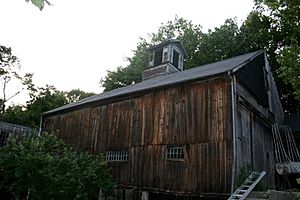
Little brown bats live across most of North America. Their range goes from Alaska and Canada down to parts of Southern California and the northern areas of Arizona and New Mexico.
Where They Rest During the Day
During the day, little brown bats rest in sheltered spots. These can be human buildings or natural places like tree hollows, wood piles, or rocky areas. They like roosts that are warm and dark. For maternity colonies, females prefer roosts that are between 23.3 and 34.4 degrees Celsius (73.9 and 93.9 degrees Fahrenheit).
Where They Hibernate in Winter
In winter, little brown bats hibernate in caves or old mines. Females can travel hundreds of kilometers to reach these hibernation spots. They prefer places with high humidity (over 90%) and temperatures above freezing that stay constant.
Where They Hunt for Food
Little brown bats hunt for food along the edges of forests and near water, like streams. In one study, they hunted much more in old-growth forests than expected.
Protecting Little Brown Bats
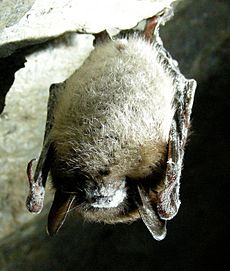
As of 2018, the little brown bat is listed as an endangered species by the IUCN. This is a big change from 2008, when it was considered a species of "least concern." It used to be one of the most common bats in North America.
The main reason for this change is white-nose syndrome. This disease has killed over one million little brown bats in the Northeastern United States between 2006 and 2011. In some areas, populations have dropped by as much as 99%.
White-nose syndrome first appeared in New York in 2006 and has spread across the continent. In 2016, it was found on a bat in Washington state, showing a huge jump in its spread.
Scientists predicted in 2010 that the little brown bat could face local extinction by 2026. They thought the population of 6.5 million could shrink to just 65,000. However, some small groups of bats have survived in the Northeast. While many bats die from the disease, some do survive exposure.
In 2010, experts suggested listing the little brown bat as federally endangered in the U.S. under the Endangered Species Act of 1973. As of 2018, it is not federally listed, but several U.S. states have listed it as endangered or threatened. In Canada, it was listed as an endangered species in 2012.
Little Brown Bats and People
Little brown bats often live near people. Female bats might form maternity colonies inside buildings. Because they are small, they can get into tiny gaps or holes, even as small as 1.5 by 0.25 inches (3.8 by 0.64 centimeters). Once inside, their sounds and droppings (guano) can bother people. Large amounts of guano can also lead to the growth of fungi.
The little brown bat is one of the most common bats tested for rabies in the United States. However, as mentioned, they rarely test positive for the virus.
People sometimes put up bat houses to attract bats. Some hope to move bats out of their homes into these bat houses. While this works for some bat species, it's not always effective for little brown bats, though they might use bat houses if their original roosts are destroyed. Others install bat houses to help bats because of white-nose syndrome or to control insects like mosquitoes.
Little brown bats can be at risk near roads. They might fly lower when crossing roads if there isn't much tree cover.
Images for kids
See also
 In Spanish: Pequeño murciélago café para niños
In Spanish: Pequeño murciélago café para niños



